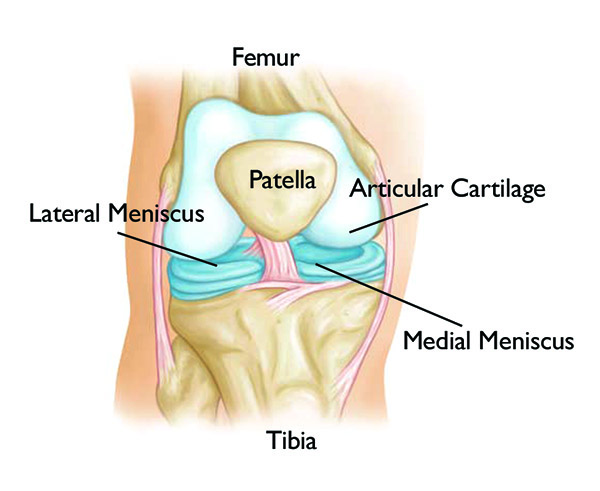Treatment
Meniscal Transplant Surgery
The meniscus is a C-shaped cushion of cartilage in the knee joint. When people talk about "torn cartilage" in the knee, they are usually referring to a torn meniscus.
If the meniscus is so badly damaged that it cannot be repaired, it may need to be removed or trimmed out. This is called a partial meniscectomy and is often effective in relieving the pain of a meniscus tear.
When the meniscus is largely gone, however, you may have ongoing knee pain, and osteoarthritis can develop. For many older patients with this condition, a total or partial knee replacement might be the right option. Active people who are younger than 40 may be eligible for an alternative treatment: meniscal transplant surgery.
A meniscal transplant replaces the damaged meniscus with donor tissue matched for size.
Meniscal transplants are not right for everyone. If you already have arthritis in your knee, a meniscal transplant may not help you. For a select group of people, however, meniscal transplants can offer significant pain relief.
Anatomy
Three bones meet to form the knee joint: the femur (thighbone), tibia (shinbone), and patella (kneecap).
The ends of the thighbone and shinbone are covered with articular cartilage. This slippery substance helps your knee bones glide smoothly across each other as you bend or straighten your leg.
Two wedge-shaped pieces of meniscal cartilage act as "shock absorbers" in the knee joint. Different from articular cartilage, the meniscus is tough and rubbery to help cushion and stabilize the joint. Each knee has two menisci, one on each side of the joint.
Description
If your meniscus is severely damaged or has been removed, the articular cartilage protecting your knee may begin to wear, similar to how rubber on a car tire wears away over time. As this cartilage wears away, it can lead to pain and disability. This condition is called osteoarthritis.
The goal of meniscal transplant surgery is to replace the meniscus cushion before the articular cartilage is damaged. The donor meniscus is intended to take the place of the native meniscus, relieve knee pain, and prevent the progression to osteoarthritis.
Allograft Preparation
Healthy cartilage tissue is taken from a cadaver (human donor) and frozen. This tissue is called an allograft. It is sized, tested for disease, and stored. Correct sizing is one of the most important factors in the success of the transplant. Later, the allograft will be matched by size to a candidate for the procedure.
Allograft Safety
A screening process is performed before selecting a possible donor. Someone who knows the donor well is interviewed to help identify risk factors that would prevent the use of the donor tissue.
Once selected, the donor tissue undergoes many tests. The safety of the tissue is monitored by the American Association of Tissue Banks and the United States Food and Drug Administration. The tissue is tested for viruses like those that cause HIV/AIDS, West Nile virus, and hepatitis B and C, as well as for bacteria.
A meniscal transplant is not like a heart or lung transplant, in which "rejection" can occur. Additionally, patients do not need to be on immunosuppressants or other medications after the procedure.
Patient Eligibility
Although meniscal transplants have been performed for around 25 years, the procedure is still relatively uncommon. This is largely due to the strict criteria patients must meet to be considered for the procedure.
Most people with severe meniscal problems have also developed arthritis in the knee. If the articular cartilage has worn away too much, a meniscal transplant will not be helpful.
The criteria for meniscal transplant include:
- Younger than 40 to 45 years and physically active
- Missing a significant portion of the meniscus as the result of previous surgery or injury
- Persistent activity-related pain
- Knee with stable ligaments and normal alignment (alignment issues can also be corrected at the time of the transplant with a procedure called an osteotomy)
- No or minimal knee osteoarthritis and no rheumatoid arthritis
- Not obese
Surgery
Meniscal transplant surgery is an arthroscopic procedure that usually needs one or two small incisions. It is typically performed on an outpatient basis.
Procedure
Knee arthroscopy is one of the most commonly performed surgical procedures. In this procedure, the surgeon inserts a miniature camera through a small incision (portal) in the knee. This provides a clear view of the inside of the knee. They then insert surgical instruments through other small incisions to perform the procedure.
The new meniscal tissue is anchored into the shinbone to stabilize the transplant. More stitches are placed into the meniscal transplant to sew it into place and attach it to the knee capsule.
Surgical Complications
The risk of complications from meniscal transplant surgery is very low. Stiffness, reoperation, and incomplete healing are the most common complications.
Other risks include bleeding, infection, and damage to nearby nerves or blood vessels.
The risk of getting an infection from donor tissue is extremely low.
Rehabilitation
Immobilization. You will need to wear a knee brace and use crutches for the first 4 to 6 weeks after surgery. This gives the transplanted tissue time to become firmly attached to the bone. Range of motion is typically initiated as soon as possible after the procedure.
Physical therapy. Once the initial pain and swelling have settled down, physical therapy can begin. Physical therapy initially focuses on pain management, muscle reactivation, and motion. Gentle stretches will improve range of motion. As healing progresses, strengthening exercises will gradually be added to your program.
Return to daily activities. Most patients are not able to return to work for at least 2 weeks after surgery. Patients with active or labor-intensive jobs may require 3 to 4 months of rehabilitation before they return to work. Your doctor will talk to you about when it is safe to return to work.
The decision about whether or not to return to sport after meniscal transplant will be a shared decision between you and your surgeon.
Outcome
Many factors contribute to the success of a meniscal transplant. These include:
- The condition of the knee at the time of surgery
- Correct sizing of the transplant
- The technique of placing the tissue
- The patient's commitment to rehabilitation
- The patient's health
- Normal alignment of the knee
Studies on meniscal transplants show that outcomes are not perfect. Overall, between 21% and 55% of transplants fail within 10 years. Meniscal transplants on the lateral (outside) part of the knee are more successful than those on the medial (inside) part of the knee.
Meniscal transplants can be quite helpful but are not a good option for every patient. For patients who are carefully selected, meniscal transplant surgery can provide significant benefits.
To assist doctors in the management of meniscus injuries, the American Academy of Orthopaedic Surgeons has conducted research to provide some useful guidelines. These are recommendations only and may not apply to every case. For more information: Clinical Practice Guideline - Acute Isolated Meniscal Pathology - AAOS
Contributed and/or Updated by
Peer-Reviewed by
AAOS does not endorse any treatments, procedures, products, or physicians referenced herein. This information is provided as an educational service and is not intended to serve as medical advice. Anyone seeking specific orthopaedic advice or assistance should consult his or her orthopaedic surgeon, or locate one in your area through the AAOS Find an Orthopaedist program on this website.








